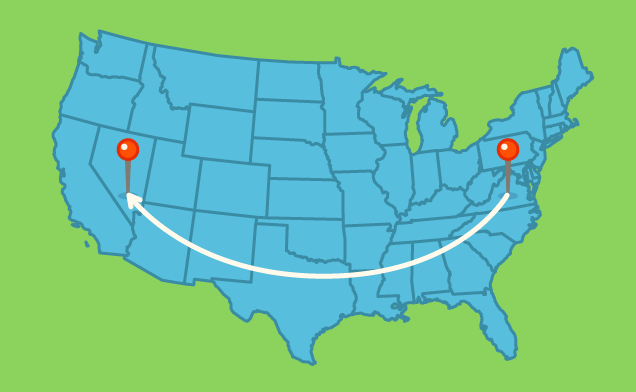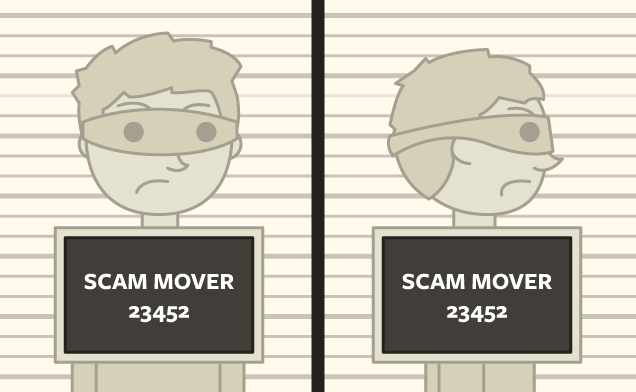The Self-Movers Guide to Relocating for Work
If you’re thinking of moving for a new job, you’re not alone. In 2012, nearly six million people moved for job-related reasons, according to the U.S. Census Bureau. And while the total number of movers only inched up less than a half percent compared to the year before, it indicates a growing trend of people who are willing to relocate to find work or upgrade to a better job.
With high rates of unemployment still lingering in many cities, more and more people are looking at relocating for better job prospects or a chance at a promotion and higher pay. A 2011 CareerBuilder survey and found that 44% of workers said they would be willing to relocate for a career opportunity. Likewise, recent graduates are in the unique position of competing for jobs with a disproportionate amount of more seasoned candidates, making relocation a more viable option than ever before when it means a higher likelihood of getting hired.
There are generally two types of career movers: those who’ve landed a job with a company that’s providing a relocation package and those who want to relocate in hopes of finding a rosier employment picture elsewhere and will need to foot the bill for the move. For the latter, a DIY approach is often necessary to find the right job and move to the right place. There are a few key points to consider when moving yourself for work –including what to do when you get there (most importantly, finding a place to live) – and Moveline is here to be your guide with tips and advice from experts and movers who’ve been there and packed that.

Why move? The happiness factor
We know this much is true: going to work everyday in a job you hate can make life miserable. When you find yourself trudging into work and avoiding your boss like Peter Gibbons in the movie Office Space, it may be high time to get a better gig. Similarly, that low-wage job that kept you afloat in college likely won’t cut the mustard now that you’ve earned that degree. After all, if it would, what was the point of college?
According to CareerBuilder, 77% of workers who relocated reported they were happy with the move and didn’t regret it. Of these happy workers, 30% said it gave them a fresh start, 31% said they made new friends, 29% reported they’ve had new experiences they wouldn’t have had anywhere else, and 22% said they’ve now got better long-term career opportunities. So, while picking up and moving might be risky, there’s a good chance it could be well worth it.

The upside of moving yourself
Let’s say you’ve done the research and think that moving to a new city should increase your chances of snagging a great position, but either you haven’t found a job yet or the company you want to work for can’t afford your relocation. Depending on your industry and the type of work you’re looking for, sometimes getting a company to pay for your move just isn’t an option. If it is an option however, be sure to check out our How to Negotiate a Relocation Guide.
Those moving to a new city without a job offer will need to foot the cost of a move themselves, but there are some advantages to being a self-mover: namely, you call the shots in terms of the schedule and timing of your move. Since you’ll be paying the bills, you can also choose the mover and timeline that suits your needs. If you own a home, you have time to sell or rent it. If you need to explore the job market in the new city and do some job hunting long distance, there’s time for that too. But before we jump into the DIY approach for self-movers, let’s first cover some bases to increase the odds that your job hunt in the new city will be successful. After all, that’s why you’re moving, and unless you’re okay with dipping into your savings to pay bills indefinitely, you’ll want to land that new job as quickly as possible.

No job? Time to tap your network
The minute you make up your mind to move to a particular area, you should start tapping your network for job leads. Everyone you know should be aware of where you’re moving and what type of position you’re looking for. Is your LinkedIn profile looking a bit dated? Brush it up and, while you’re at it, go ahead and change your home city. If you belong to any professional organizations, check to see if there’s a chapter or other groups like it where you’re going; then, transfer your membership and plan to attend upcoming events. If you haven’t already, get out and network before and after the move. Join the new city’s chapter of your alumni association, if it has one. Find out who’s hiring in the area and ask for referrals.
When Shana, 30, a business marketing strategist, decided to move from Seattle to Austin without a job, she started by updating her LinkedIn profile and location. Then she began making contacts in Seattle and Austin and alerting professional contacts in her network about the move. Once in Austin, she interviewed with recruiters – almost all of which originated from contacts she made through her profile. She also attended local meet-ups for SEO, PR and other topics related to her industry. After two weeks without an offer, a temp agency approached her with a contract position in the marketing department of a healthcare company. It wasn’t her dream job, but the pay was good, so she accepted.
“There was a lot of money going out, with not much coming in and I didn’t want to dip into my savings,” says Shana.
You might be asking whether just posting your resume to job boards or applying online is enough – it’s not. While career sites and company job postings are useful tools for getting a feel for what’s out there and what types of skills are in demand, passively submitting your resume online isn’t enough to land the job you want quickly. People want to hire people, not a resume. Get out there and get some face time in with those in your industry who can steer you to where the good jobs are – especially those that aren’t posted yet and therefore may have less competition.

Moving and storing your stuff
Now that your job search is underway, it’s time to figure out just how to get you and your stuff to the new city. Consider whether you should move everything at once or store it while you look for work. Moving now and storing your stuff for later might be a good option if you’re not ready to commit to moving everything right away, especially if it’s easier and cheaper to find storage where you currently live. It’s important, however, to think critically about exactly what belongings you’ll need to keep with you in order to be comfortable for several weeks or even months.
Shana decided to leave her stuff in Seattle and split the cost of storing it with a friend who happened to be moving to Houston at the same time. Neither had jobs in Texas, so they would both be paying out of pocket for the cost of their relocations. They agreed to figure out how they would move their belongings after they got settled. That still left the remainder of her stuff – mostly clothes and her 20-year-old car, which she doubted could make the trip. She ended up flying to Austin, mailing the clothes, and hiring a vehicle moving company for her car.
She rented a furnished bedroom in a house she found on Craigslist, so she wouldn’t need to rest of her things immediately. Her friend ended up getting a job with a company that paid to move everything in their Seattle storage unit to Houston. Shana later moved into one-bedroom house by herself and traveled to Houston with a borrowed truck and rented trailer to get her stuff. The whole process took several weeks. For nearly a month she lived in her new one-bedroom furnished only with an air mattress and a TV. She says if she had it to do again, she would have moved everything when she left Seattle.
“I wouldn’t recommend it doing what I did. For a long time it felt like I was squatting in my own home because I didn’t have anything.”
Renting storage and protecting your stuff
Sometimes there’s no getting around it: you need to store some or all of your belongings while you’re in between cities. It’s so common, in fact, that Moveline often factors the cost of storage into its customers’ moves. The point of storage is to keep your items safe until you have space to live with them again. That means choosing a storage space suitable for what you’re storing. Delicate items such as furniture, clothing or anything else susceptible to damage in hot or humid conditions should be stored in a climate-controlled space. Yes, it costs extra, but consider the cost of replacing your sofa should it grow mold and spoil in an unprotected storage unit. And speaking of units, beware of the ones – even those labeled as climate-controlled – that face exterior walls; those that do might not provide enough protection from the elements, especially in hot climates.

The minute you make up your mind to move to a particular area, you should start tapping your network for job leads. Everyone you know should be aware of where you’re moving and what type of position you’re looking for. Is your LinkedIn profile looking a bit dated? Brush it up and, while you’re at it, go ahead and change your home city. If you belong to any professional organizations, check to see if there’s a chapter or other groups like it where you’re going; then, transfer your membership and plan to attend upcoming events. If you haven’t already, get out and network before and after the move. Join the new city’s chapter of your alumni association, if it has one. Find out who’s hiring in the area and ask for referrals.
When Shana, 30, a business marketing strategist, decided to move from Seattle to Austin without a job, she started by updating her LinkedIn profile and location. Then she began making contacts in Seattle and Austin and alerting professional contacts in her network about the move. Once in Austin, she interviewed with recruiters – almost all of which originated from contacts she made through her profile. She also attended local meet-ups for SEO, PR and other topics related to her industry. After two weeks without an offer, a temp agency approached her with a contract position in the marketing department of a healthcare company. It wasn’t her dream job, but the pay was good, so she accepted.
“There was a lot of money going out, with not much coming in and I didn’t want to dip into my savings,” says Shana.
You might be asking whether just posting your resume to job boards or applying online is enough – it’s not. While career sites and company job postings are useful tools for getting a feel for what’s out there and what types of skills are in demand, passively submitting your resume online isn’t enough to land the job you want quickly. People want to hire people, not a resume. Get out there and get some face time in with those in your industry who can steer you to where the good jobs are – especially those that aren’t posted yet and therefore may have less competition.
Also, check to see if your homeowner’s or renter’s insurance policy will cover your belongings while they’re being stored. If they’re not covered or if you don’t already have insurance, look into getting a policy from your insurance company or purchase coverage directly from the storage facility.
Tax Tip:
If you relocated for a new full-time job at least 50 miles away from your previous home, you can deduct the cost of packing, transporting or storing your household goods. Check with the IRS or ask your tax professional to find out what expenses are eligible for deduction.

Hiring movers and avoiding scams
While there are many good, honest local and national movers out there, too often we hear about unscrupulous movers and scams. Before you hire any type of mover, whether for your vehicle or household goods, spend time researching your rights and your options given your budget and moving timeline.
Keep in mind finding reputable movers that fit your budget and timeline can take a lot of time and legwork. Shana says it was difficult to find a reputable car mover. The company she ultimately hired was several days late getting her car to Austin. When she called to ask about it, the company acted cagey and said the moving truck was late because the police had stopped it and searched her car. There was nothing she could do but be patient.
Know your rights
Although moving companies are require to share a rights & responsibilities booklet with you (published by the US Department of Transportation), you don’t have to wait on them; you can read it beforehand and get familiar with the basics of movers’ rights.
Timing matters
For the best rates and greatest amount of options, start your planning process early – several months is ideal – and free yourself up for the opportunity to work with whatever mover you choose, rather than letting your last-minute circumstances choose for you. Also, it’s wise to understand what a delivery spread is so you can time your move as efficiently as possible.
Watch out for scams and identity theft
When shopping around for moving services, be on the lookout for scams. Never give out personal information when getting quotes online. Call moving companies directly to ask for their rates and availability and make sure those you do call are reputable, licensed and insured.
Get fair, accurate quotes
The inventory process is a make-it-or-break-it element of any moving budget. While you may estimate, for example, that you need 30 boxes and a couple hours of professional movers’ time to get the job done, that super-affordable-sounding quote won’t be so super if you ultimately wind up needing 60 boxes and twice as many hours of moving time. In fact, the cost can more than double over a simple miscalculation.

That’s one of the many reasons Moveline was developed – to take the guesswork out of moving. With special software developed to demystify the inventory process, Move Captains work on behalf of customers for free to obtain reasonable, relevant quotes that won’t change (i.e., spike) on moving day. Take a spin through the How Moveline Works page to learn about Move Captains and how to avoid home visits from prospective movers with an easy video inventory process.

Find temp and rental housing
Finding temporary or rental housing from hundreds – or thousands – of miles away can be a huge challenge. If you’re planning to buy a home in the new city or just want time to search locally for a rental, temporary housing may be the way to go. Luckily, several resources have come online in the last few years that can make the search easier. Airbnb.com, Sublet.com, and Homeaway.com all list rental properties available by the day, week or month.
Before arriving in Austin, Shana found a furnished bedroom in a home with a roommate on Craigslist and rented it sight unseen. She soon discovered that while the house was in an ideal location, the neighborhood was rough and she didn’t feel safe walking to stores, bus stops and restaurants – something she needed to do since she didn’t yet have a car. She instantly regretted her decision.
“I felt like the ad was misleading,” she says. “I just knew I needed to get the hell out of that situation.”
If you want to use Craigslist but are wary of scams, consider using Wegolook.com. Launched in 2010, the site has 7,400 “local lookers” who’ll visit the property you’re considering. For $59, you’ll get a basic report on what they find complete with photos and videos.
Want to cut costs and don’t mind sharing space? Check out roomster.com, roommates.com and roomiematch.com, which promises to help you find a roommate without getting scammed.

Getting settled: Feathering your nest (on the cheap)
You just spent more money than you probably wanted to on your move, including paying the security deposit on your new rental home. The last thing you need now are lots of home decorating expenses eating away at your nest egg while you start your new job or continue the search. Here are a few easy ways to get what you need to make your rental home without breaking the bank.
Garage sales
Yes, you could shop everything online (Etsy and Amazon, we’re looking at you), but what’s the fun in that? Sometimes hunting for home stuff in the real world is just the excuse you need to get out and explore. Check your local classifieds or cruise your neighborhood for garage sale signs – they usually start popping up in yards and street corners on Thursdays to advertise a Saturday garage or “estate” sale. These can be great opportunities to pick up gently used but still good quality home basics like dishes, bed frames, or even art.
Flea markets and vintage shops
If you don’t need the latest styles and trends in your home or if you just have a thing for the vintage look, then try treasure hunting at flea markets and vintage stores and secondhand stores like Goodwill and Salvation Army, where you can score bargains at a fraction of what you’d pay for new stuff at big box stores. Bonus: all the driving around town to shop will help you become acquainted with your new city and maybe find some other neighborhoods you’d like to try when your lease expires.

Paint and (temporary) wallpaper
Paint can work miracles when it comes to transforming the bland beige box that is the average rental into something a little more interesting and certainly more “you.” Don’t want to shell out the cash to pay for window treatments in your living room? Paint an accent wall. Kitchen cabinets need a facelift? Try painting and adding new hardware. If you need help deciding on a color, check out the color guides available at paint and home improvement and stores. Here, actual home designers have done the hard work – sifting through thousands of color choices with obscure names like Harvest Moon – and selected the shades most likely to work for you. As with any type of painting project, always ask your landlord first or else risk getting hit with a hefty bill upon move-out. If you can’t paint, try temporary wallpaper. It’s basically a big sticker that comes off clean (no wall damage) and can add color and pattern to your space.

Ready to roll?
Moving for work is more than just about work; it’s a move that changes your life – where you call home, what you do for a living, who makes up your social network, and what your opportunities are in the future. It’s a huge step that requires careful planning and consideration to make it a success. So before you make the jump to a new city, get a moving quote from Moveline to help simplify the process for you. We’re here to take the stress out of the moving process so you can spend your time, money and energy on more important things in your new home. Life is short, so enjoy it… and don’t go it alone.
